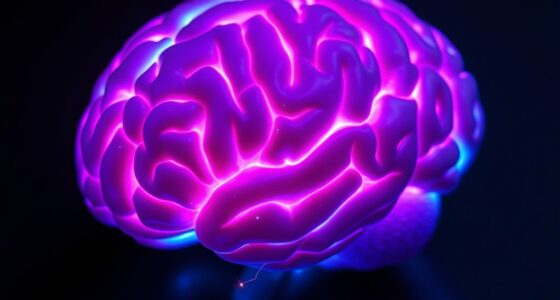Researchers have successfully implanted false memories in mice, revealing how memories can be manipulated through precise neural techniques like optogenetics. This breakthrough shows that memories aren’t fixed but are reconstructed, opening new avenues for understanding how our brains store and recall information. While it raises ethical concerns about human memory manipulation, it also provides valuable insights into consciousness and identity. If you stay curious, you’ll discover more about how this discovery could impact future neuroscience research.
Key Takeaways
- Scientists have demonstrated that false memories can be implanted in mice using optogenetic techniques.
- These findings reveal that memories are reconstructive, not static, and can be manipulated through targeted neural rewiring.
- The research provides insights into how specific brain circuits influence memory formation and recall.
- Understanding memory manipulation in animals informs potential applications and ethical considerations for human memory technologies.
- The study raises important questions about the ethical use and risks of memory modification in humans.

Researchers have successfully implanted false memories in mice, demonstrating that memory formation can be manipulated with remarkable precision. This breakthrough opens new doors in understanding how memories work and how they can be altered. As scientists delve deeper into the mechanics of memory manipulation, questions about the ethical implications of such research inevitably arise. If we can create or erase memories in animals, it prompts us to consider what this means for humans and our sense of identity, autonomy, and mental integrity.
Scientists can now implant false memories in mice, raising ethical questions about memory manipulation and human identity.
The ability to implant false memories in mice shows that memories are not fixed, but can be influenced by specific neural manipulations. Techniques like optogenetics allow researchers to target precise brain circuits involved in memory encoding and retrieval. By activating or silencing these circuits, scientists can induce a false perception of events that never occurred. This demonstrates that memories are reconstructive rather than static, and that neural pathways can be rewired or tricked into creating fabricated experiences. Additionally, the understanding of mindfulness techniques can help mitigate the potential psychological impacts of such manipulations by fostering awareness and acceptance of one’s mental processes.
As you consider these advances, you must also think about the ethical implications. Manipulating memories in animals might seem less troubling than doing so in humans, but it raises important concerns. For example, if scientists can induce false memories in mice, could similar techniques someday be used on humans? If so, what are the risks of misuse or abuse? Could memory manipulation be weaponized to distort truth, erase traumatic experiences, or manipulate perceptions? These questions remind us that, while the science is fascinating, it carries a heavy moral responsibility to make certain that research is conducted ethically.
Moreover, ethical considerations extend beyond the potential misuse of memory manipulation techniques. You should think about the welfare of the animals involved in such experiments. Making certain that scientific progress doesn’t come at the cost of unnecessary suffering remains essential. Researchers are tasked with balancing the pursuit of knowledge with the moral obligation to treat animals ethically, minimizing harm while pushing the boundaries of what we understand about the brain.
In the end, this breakthrough highlights both the incredible potential and the profound ethical dilemmas associated with memory manipulation. As you follow these developments, it’s essential to stay aware of the broader implications—not only for scientific discovery but also for society’s understanding of consciousness, identity, and moral responsibility. While the ability to implant false memories in mice advances our knowledge, it also urges us to carefully consider the ethical frameworks that will guide future research in this powerful, yet sensitive, field. Exploring mindfulness practices may provide avenues for fostering ethical reflection and emotional resilience as we navigate these complex scientific terrain.
Frequently Asked Questions
Can False Memories Be Distinguished From Real Ones?
You can’t always easily distinguish false memories from real ones because neural differentiation isn’t perfect. Your brain’s processes may blur the lines between genuine experiences and fabricated ones, affecting memory accuracy. Factors like emotional intensity or suggestive cues can influence this. As a result, false memories can feel just as vivid and convincing, making it challenging to tell them apart from authentic ones, especially without external verification or detailed analysis.
What Are Potential Ethical Concerns With Memory Implantation?
Imagine opening Pandora’s box—memory manipulation raises profound ethical concerns. You might worry about crossing ethical boundaries, where altering memories could distort identity or manipulate choices. As technology advances, safeguarding autonomy becomes essential, yet pushing these limits risks misuse or unintended harm. You must consider if tampering with memories respects individual integrity or threatens personal freedom, making it imperative to establish strict ethical guidelines before exploring this powerful yet risky frontier.
How Might This Research Influence Treatments for Memory-Related Disorders?
This research could revolutionize memory modification and therapeutic applications by offering new ways to treat conditions like PTSD or Alzheimer’s disease. You might benefit from targeted memory interventions, helping you weaken traumatic memories or strengthen positive ones. It opens up possibilities for precise, safe therapies that improve mental health, allowing you to regain control over distressing memories and enhance cognitive well-being through advanced memory modification techniques.
Could False Memories Be Used for Malicious Purposes?
Think of memory manipulation as wielding a double-edged sword; it can heal or harm. Yes, false memories could be used maliciously, risking manipulation and deception. The ethical implications are serious, as tampering with someone’s mind breaches trust and autonomy. You must consider how this power could be exploited to distort truth, control perceptions, or harm individuals, emphasizing the need for strict safeguards and responsible use of such groundbreaking technology.
What Are the Limitations of Translating Mouse Memory Studies to Humans?
You should recognize that translating mouse memory studies to humans faces limitations due to differences in neural circuitry and complexity. Human brains have more intricate neural networks, making direct application challenging. Additionally, ethical implications arise when manipulating human memories. You must consider these factors carefully, as what works in mice might not be safe or effective for humans, emphasizing the need for cautious, responsible research.
Conclusion
Imagine planting a seed in a garden, only to watch it sprout into a memory you thought was real. That’s what researchers have done with mice—successfully implanting false memories. This breakthrough is like discovering a new map for the brain’s maze, showing us how fragile and malleable our memories can be. It’s a reminder that what we remember might be more about perception than fact, opening new paths for understanding human consciousness.









